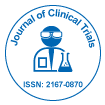
Journal of Clinical Trials
Open Access
ISSN: 2167-0870

ISSN: 2167-0870
Commentary - (2025)Volume 15, Issue 2
Drug clinical trials are essential for determining the safety and effectiveness of new medications before they reach the public. These trials form a systematic process that helps researchers evaluate how a drug interacts with the human body and whether it can effectively treat or prevent a specific condition. Conducted in multiple stages, clinical trials follow strict scientific and ethical guidelines to ensure that the results are reliable and that participants are protected throughout the study.
The purpose of clinical trials
At their core, clinical trials are designed to answer specific questions about new drugs. These may include how well a drug treats a disease, what side effects may occur, what does is most effective and how it compares to existing treatments. Without these trials, it would be impossible to know whether a medication is suitable for public use.
Clinical trials also help uncover any unexpected reactions or interactions that might not be visible during earlier laboratory or animal testing. These findings are vital for protecting public health, as they identify potential risks that must be addressed before a drug is approved.
Phases of clinical trials
Clinical trials are typically divided into four main phases, each with a specific goal:
• Phase I focuses on assessing the safety of a new drug. A small group of healthy volunteers is given the drug and researchers monitor how it is absorbed, metabolized and excreted. This phase helps determine the safe dosage range and identifies possible side effects.
• Phase II involves a larger group of participants who have the condition the drug is meant to treat. This stage examines how effective the drug is, while continuing to collect safety data. Researchers also begin to refine the dosage and method of administration.
• Phase III expands the trial to a much larger population, often involving hundreds or thousands of participants across different locations. The goal is to confirm the drug’s effectiveness, monitor side effects and compare it to existing treatments. Data from this phase is typically submitted to regulatory agencies for approval.
• Phase IV takes place after the drug has been approved and is on the market. These studies gather further information about the drug's long-term effects, interactions with other medications and overall impact on quality of life. This ongoing monitoring helps ensure continued patient safety.
Design and methodology
The design of a clinical trial is carefully planned to ensure that the results are meaningful and unbiased. Common features include:
Randomization: Participants are randomly assigned to different groups, such as a treatment group and a control group. This helps prevent selection bias and ensures that the groups are comparable.
Blinding: In many trials, neither the participants nor the researchers know who is receiving the experimental drug and who is receiving a placebo. This method helps eliminate bias in reporting and observing results.
Control groups: These groups receive a standard treatment or a placebo, providing a basis for comparison. By observing differences in outcomes, researchers can determine whether the experimental drug is effective.
Ethical considerations
Ethical oversight is a key part of clinical trials. Every trial must be reviewed and approved by an independent ethics committee or Institutional Review Board (IRB). These bodies ensure that the rights and well-being of participants are protected.
Informed consent is another fundamental requirement. Before joining a trial, participants must be given detailed information about the study, including its purpose, procedures, potential risks and their rights. They must voluntarily agree to participate and can withdraw at any time without penalty.
Additionally, clinical trials must be designed to minimize risks and avoid unnecessary harm. Trials involving vulnerable populations, such as children or individuals with cognitive impairments, require additional protections.
Challenges in clinical trials
While clinical trials are essential, they also face a number of challenges. Recruiting enough suitable participants can be difficult, particularly for rare diseases or conditions that have a limited patient population. Ensuring diversity among participants is another challenge, as trials must reflect a broad range of ages, ethnicities and backgrounds to ensure results are widely applicable.
Another concern is the high cost of conducting trials. These studies often require significant investment in staff, facilities, equipment and data analysis. Delays or failures in trials can be financially costly and may set back the development of needed treatments.
Regulatory oversight and approval
Before a drug can be sold to the public, it must be reviewed and approved by national regulatory authorities, such as the U.S. Food and Drug Administration (FDA) or the European Medicines Agency (EMA). These agencies examine data from all trial phases to determine whether the benefits of a new drug outweigh its risks.
Approval is granted only if the evidence supports the drug’s safety and usefulness. After approval, regulators continue to monitor the drug’s use in the general population, requiring companies to report any adverse events or issues that arise.
Clinical trials are a fundamental part of medical research and drug development. They provide a pathway to discover, evaluate and refine treatments that can improve health outcomes. Through careful planning, ethical oversight and rigorous scientific methods, clinical trials help ensure that new drugs are safe and effective for the people who need them most.
Citation: Vincent J (2025). Exploring the Path of New Medicines: Understanding Each Phase of Clinical Trials and Their Role in Drug Development. J Clin Trials. 15:583.
Received: 25-Feb-2025, Manuscript No. JCTR-25-37243; Editor assigned: 27-Feb-2025, Pre QC No. JCTR-25-37243 (PQ); Reviewed: 14-Mar-2025, QC No. JCTR-25-37243; Revised: 21-Mar-2025, Manuscript No. JCTR-25-37243 (R); Published: 28-Mar-2025 , DOI: 10.35248/2167-0870.25.15.583
Copyright: © 2025 Vincent J. This is an open-access article distributed under the terms of the Creative Commons Attribution License, which permits unrestricted use, distribution and reproduction in any medium, provided the original author and source are credited.